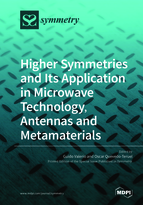Higher Symmetries and Its Application in Microwave Technology, Antennas and Metamaterials
A special issue of Symmetry (ISSN 2073-8994). This special issue belongs to the section "Physics".
Deadline for manuscript submissions: closed (15 March 2019) | Viewed by 28363
Special Issue Editors
Interests: antennas and propagation; periodic structures and metamaterials; higher symmetries; numerical methods, analytical modeling; leaky-waves; multilayered media
Interests: metasurfaces; lens antennas; geodesic lens; higher symmetries; transformation optics
Special Issues, Collections and Topics in MDPI journals
Special Issue Information
Dear Colleagues,
Artificial materials and surfaces are widely used in leaky-waves, holographic surfaces, band-gap materials, and graded-index flat lenses. However, their practical implementations are usually limited in terms of bandwidth, losses, fabrication precision, and input-matching. Approaches overcoming these limitations have recently been proposed through the implementation, or the breaking, of specific higher symmetries in each cell of the periodic medium. Spatial symmetries involve glide or twist symmetry, while an example of spatio-temporal symmetries is the parity-time symmetry.
Ultra-wide behaviors, large stop bands, wave propagation robust to defects and deformations are among the effects that can be achieved with these symmetries. They can lead to the novel generation of lenses, gap waveguides and filters with applications at millimeter-waves and higher frequencies: next-generation communication terminals, satellite communications, radio-astronomy, etc.
Prof. Guido Valerio
Prof. Dr. Oscar Quevedo-Teruel
Guest Editors
Manuscript Submission Information
Manuscripts should be submitted online at www.mdpi.com by registering and logging in to this website. Once you are registered, click here to go to the submission form. Manuscripts can be submitted until the deadline. All submissions that pass pre-check are peer-reviewed. Accepted papers will be published continuously in the journal (as soon as accepted) and will be listed together on the special issue website. Research articles, review articles as well as short communications are invited. For planned papers, a title and short abstract (about 100 words) can be sent to the Editorial Office for announcement on this website.
Submitted manuscripts should not have been published previously, nor be under consideration for publication elsewhere (except conference proceedings papers). All manuscripts are thoroughly refereed through a single-blind peer-review process. A guide for authors and other relevant information for submission of manuscripts is available on the Instructions for Authors page. Symmetry is an international peer-reviewed open access monthly journal published by MDPI.
Please visit the Instructions for Authors page before submitting a manuscript. The Article Processing Charge (APC) for publication in this open access journal is 2400 CHF (Swiss Francs). Submitted papers should be well formatted and use good English. Authors may use MDPI's English editing service prior to publication or during author revisions.
Keywords
- Glide
- Twist
- Lenses
- Antennas
- Photonics
- Metamaterials
- Metasurfaces
- Microwave
- Electromagnetic band-gap
- Dispersive analyses







